Equinox, Part II works worse than it should.
Equinox, Part II is undercut by three key factors. The most obvious is the premise itself. Equinox, Part I and Equinox, Part II tell a story that is baked into the DNA of Star Trek: Voyager, but there is a sense that the production lacks the will to tell that story. Secondly, Equinox, Part I and Equinox, Part II struggle with consistent characterisation and clear narrative arcs. The third factor is a sense of inevitability, with Equinox, Part I and Equinox, Part II feeling like they reveal nothing insightful about Voyager before concluding, and that the show will no lasting impact.

Fish out of fluidic space.
These three factors squander a lot of raw potential. Equinox, Part II is telling a story that feels essential to Voyager, a story that the franchise arguably should have been telling immediately after Caretaker. This season premiere represents the chance for Voyager to have a full and frank discussion with itself, particularly in the context of its sixth season. Star Trek: Deep Space Nine had concluded at the end of its seventh season. For the first time in its run, Voyager was the only Star Trek series on television. This was the perfect opportunity for introspection.
Equinox, Part II is an episode that fails to deliver upon a fantastic opportunity.

“What are you looking at?”
Equinox, Part I and Equinox, Part II should cut right to the heart of Voyager, imaging how things might have been different for Janeway and her crew. This should be a profound moment for the series, representing an existential turning point for the characters. Ransom and the Equinox serve as an effective and compelling nemesis for Janeway and Voyager, the culmination of various nods and threads seeded through fifth season episodes like Night or Nothing Human or Latent Image.
Ransom and the Equinox represent an entirely alien moral philosophy that stands diametrically opposed the Janeway and Voyager’s rigid adherence to Starfleet morality. The two ships are quite literally night and day, as the title of the two-parter suggests. Voyager is a ship of order and integrity, led by a commanding officer who refuses to compromise in the face of adversity; Equinox is a ship that has descended into horror and anarchy, led by a commanding officer who has sacrificed his humanity at the altar of expedience.

I’d pay a Captain Ransom’s Ransom for a better version of this episode.
In fact, were Voyager as ambitious with its titling as Deep Space Nine had been, Equinox, Part I and Equinox, Part II would represent the perfect opportunity to eschew the “Part I” and “Part II” convention in favour of something more adventurous like “Equinox” and “Solstice”, in the spirit of Deep Space Nine episodes like Improbable Cause and The Die is Cast or In Purgatory’s Shadow and By Inferno’s Light or Favour the Bold and Sacrifice of Angels. Those titles would seem to capture the moral arc of the larger two-parter.
Of course, Equinox, Part II never quite delivers upon that promised arc. Equinox, Part I was an episode that was largely sustained by a combination of its audacious premise, its escalating momentum, and its stellar guest cast. That was enough to get the episode across the forty-five minute mark and to the cliffhanger, the point at which Equinox, Part II became a problem for after the summer hiatus. However, Equinox, Part II does not have the same luxuries that allowed Equinox, Part I to glide to an impressive finish. Equinox, Part II needs to actually do something.

Killer crew.
Equinox, Part II is notable for a number of reasons, but it marks the arrival of writer Ronald D. Moore on Voyager. Moore had worked with Voyager showrunner Braga on Star Trek: The Next Generation. However, when The Next Generation came to an end, the two writers were split up. Braga was assigned to the first season of Voyager with Michael Piller and Jeri Taylor, while Moore got drafted on to the third season of Deep Space Nine with Ira Steven Behr. Both Moore and Braga would become defining voices on their respective Star Trek series.
When Deep Space Nine came to an end, most of the writing staff moved to other projects. Moore was convinced to remain on Star Trek, and to move over to join the writing staff working on the sixth season of Voyager. After all, Moore had worked with Brannon from the very beginning; Braga’s first script credit was on Reunion, a Klingon-centric episode of The Next Generation that was also penned by Moore. The two writers had even helped launch the Next Generation cast to the big screen by scripting Star Trek: Generations and Star Trek: First Contact.
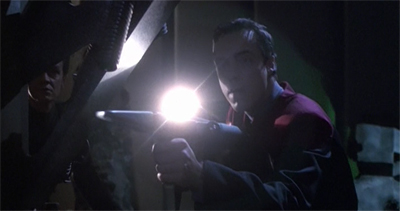
A shot in the dark.
Moore’s time on Voyager was infamously abrupt. He contributed one script to the sixth season, Survival Instinct. He also contributed the story to Barge of the Dead, an episode that was finished by Bryan Fuller. However, as a producer, Moore consulted on Equinox, Part II and was frustrated by the episode’s lack of commitment:
We sat down and approached Equinox II and tried to find what the show was about. What was the point of meeting this ship and this crew and this captain, and what did it mean? We finally landed on this idea that the two captains were going to go in opposite directions. Janeway was going to really feel the same kind of pressures and stresses that Ransom felt, and watch how it could turn a good, by-the-book Starfleet captain into what he had become. At the same time, his interaction with the Doctor and Seven of Nine would rekindle his humanity. It was this nice, double track approach, but it just got lost in the translation. It has no coherence. You’re not sure what’s really going on. You’ve got some potentially good scenes. The scenes between Janeway and Chakotay had some real fire to them, and you kind of felt like she is going off the deep end, a bit. Then she relieves him of duty, and there is this crisis of command between the two of them. But at the end of the episode, it’s just a shrug and a smile and off to the next.
This is the most fundamental question that can be asked about an episode of television, “what is this about?” To be fair, it isn’t always possible to answer that coherently while churning out twenty-six episodes in a season; there will always be episodes that don’t make sense or don’t fit.

“Ask yourself, Captain Janeway, have I done anything nearly as bad as Alliances, Tattoo or Threshold?”
However, Equinox, Part II is the season premiere. The writing staff had the entire summer break to figure out what they wanted the episode to be about. Equinox, Part I had been written and produced under a tremendous amount of time pressure, but it came together relatively well through sheer momentum and guest star talent. Equinox, Part II should have been a much easier exercise, given that the premise of the two-parter is so close to Voyager‘s heart. It is a story that has been waiting to be told for a half-a-decade, so it seems surreal that it should lack a clear second half.
In fact, Brannon Braga and Joe Menosky would not be the first Star Trek writers to write a cliffhanger without any idea about how they were going to resolve it; Michael Piller wrote The Best of Both Worlds, Part I at a point when he wasn’t even sure if he would be working on The Next Generation during the following season. René Echevarria was scripting Improbable Cause when the writing staff decided to turn it into a cliffhanger at the last minute. However, these other examples made a point to develop their ideas in their second halves.
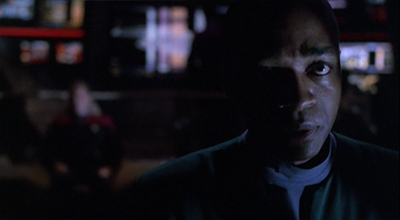
Lessing learned.
Equinox, Part II has a number of big ideas bubbling through it. Is Janeway becoming unhinged in her pursuit of Ransom? Given Janeway is trying to hold Ransom to account for abandoning his Starfleet principles, is there some irony in her willingness to breach protocol in an attempt to catch him? Can Ransom be redeemed, and can his crew? Is Janeway projecting her own sense of responsibility for her crew (suggested by Night) on to a phantom version of Ransom that she is chasing across the cosmos?
In fact, Equinox, Part II seems to set up the idea of another retread of Moby Dick within the Star Trek mythos; Voyager had riffed on that core concept as recently as Bliss. Ransom seems to be cast as the white whale to Janeway’s Ahab, a monomaniacal fixation that obscured any objectivity. This isn’t a bad idea of itself; there is a reason that the Star Trek franchise has returned to the idea of the vengeance-obsessed commanding officer in stories like For the Uniform or First Contact. However, there simply needs to be more substance underlying this.
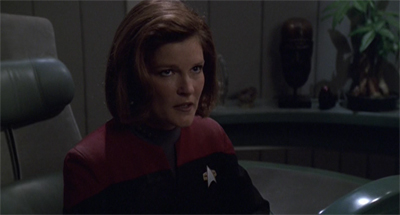
Janeway outta line.
Moore cuts right to the heart of these issue with how Voyager approached Janeway’s characterisation:
She’s having a bad day; these things keep popping around on the bridge, and we just keep cutting to shots of people grabbing phaser rifles and shooting, and hitting the red alert sign, over and over again. It doesn’t signify anything. It’s kind of emblematic of the show. There is a lot of potential, and there is a lot of surface sizzle going on in a lot of episodes, but to what end? What are we trying to do? What are we trying to touch in the audience? What are we trying to say? What are the things we are trying to explore? Why are we doing this episode? That was my fundamental question. When I would say, ‘What was the point of doing the first part?’ there was never a good answer for that. As a consequence, it was hard to come up with the ending to the show that has no beginning. You just start throwing things around. ‘Two captains on different courses’ at least sounds like an episode. At least there is something in it. Janeway will take something away from that experience, but not in the current version. What does she learn from that experience? I don’t know how it’s affected her. Chakotay, for all his trouble, he just goes back to work. There is no lingering problem with Janeway; there is no deeper issue coming to the fore.
To be fair, this has always been a problem with Voyager. Voyager is a very plot-driven show with little continuity.

(Port)al’s good, baby.
Voyager is very fond of episodes where things happen, even if those things have no collation to characters or to one another. A lot of this is down to how the writing staff on Voyager built their episodes, focusing on plot beats that mapped out an episode as a series of events. Often, it could feel like the writing staff got about two-thirds of the way through an episode before needing something more to reach the forty-five minute runtime; as a result, episodes like Alter Ego, Worst Case Scenario, Waking Moments and Demon seem to change plot once every few minutes.
Equinox, Part II suffers a great deal from this approach to writing for Voyager. The episode is a collection of things happening, but without any clear throughline or purpose underscoring it. The cliffhanger to Equinox, Part I is resolved with a convenient slice of magic technology. Using “tactical control”, Janeway manages to get the shields back up and resolve the immediate crisis. “Good guess. I used a deflector pulse to reinforce the shields. It won’t hold for long.” It feels like a cheat, the closing image of the fifth season resolved in the first two lines of the sixth.
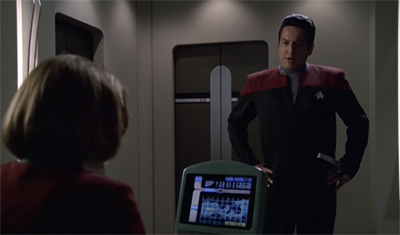
“I mean, what the tech is this even about, Kathryn?”
Equinox, Part II continues in this vein, a collection of contrivances and coincidences that serve to move the plot forward down the path of least resistance. None of these plot elements feel like organic extensions of Equinox, Part I. instead, they feel like clumsy attempts to get Equinox, Part II to where it needs to be for the plot to resolve with minimum amount of complications. Equinox, Part II moves quickly, but it lacks the ratcheting tension that made Equinox, Part I so effective.
The first major contrivance finds Voyager stumbling across Ankari vessel at just the right moment. “If there’s an Ankari vessel less than two light years from here, why haven’t we detected it?” Torres wonders.Chakotay explains, “Apparently, they use a unique form of propulsion, which makes them hard to find.” Paris follows up with an obvious question, “You think they’ll be willing to help us?” Naturally, the Ansari prove willing to help with a bit of nudging and allow Janeway to come to an understanding with the aliens that Ransom has been tormenting.
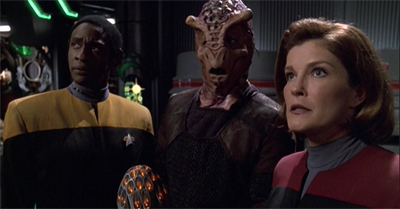
(An)kari on.
This side-steps the biggest question about the Ankari. In Equinox, Part I, Ransom explains that the enhanced warp drive allowed Equinox to travel “ten thousand light years in two weeks.” That is one seventh of the journey back to Earth. That is a lot of empty space. Given that the Ankari worship these aliens as “spirits of good fortune”, it seems unlikely that the Ankari are using similar technology to power their own engines. As such, it seems convenient that Voyager should happen to meet their first Ankari more than ten thousand light years from their home planet.
This is not the first time that Voyager has fudged its own internal logic in this manner. Kazon space seemed improbably large during the first two seasons of the show. Borg space seems span more than twenty thousand light years between the first encounter with them in Scorpion, Part I and the final face-off in Endgame. Inexplicably, entire unassimilated empires seem to exist within the final ten thousand light years of that space. The Hirogen span a gulf between Message in a Bottle and Flesh and Blood, Part II. However, this particular convenience is striking.

FAN THEORY: The Delta Quadrant is full of lots of interconnected wormholes that everybody is just too rude to actually tell Janeway about.
Similarly, Equinox, Part II relies on Seven of Nine sabotaging the enhanced drive and Ransom makes a pit stop around a planet with “a parthogenic atmosphere.” This seems a reckless move given that he can’t be sure that Voyager is destroyed; hiding in the only possible hiding place seems a poor tactical choice. However, this allows Equinox, Part II to double-down on the Moby Dick references by evoking the two-Starfleet-ships-stalking-each-other-submarine-style aesthetic employed at the climax of Star Trek II: The Wrath of Khan.
All of these elements feel like plotting contrivances, designed to spur the plot along and provide a tidy resolution to the story being told. The Equinox hides in the only place that it could hide so that Voyager can find it; Janeway captures Lessing so that she can get a sequence in which she kinda goes too far, but not so far that she has to face any consequences; there just happens to be an Ankari vessel nearby so that Janeway can make peace with the aliens attacking the Equinox. There are very few surprises in Equinox, Part II, but there are also very few plot points that build organically.

Chakotay seals a plot hole.
As Moore suggests, there is a very clear moral arc outlined in Equinox, Part II, with Janeway losing her humanity as Ransom finds his own. This would be a neat reversal of Equinox, Part I, where both characters had more rigidly-defined diametrically-opposed perspectives. As Duncan and Michèle Barrett contend in The Human Frontier:
What this story demonstrates, however, is that it is not only holograms whose ethics can be rewritten, but respected Starfleet officers.
At first glance, the title of the double-episode seems to suggest that Janeway and Ransom are equal and opposite – she representing daylight and he night. In Part II, however, we see her own ethics begin to slip – almost as if the other shop’s moral relativism is contagious. Janeway is so incensed at the way Ransom has abandoned the principles she has clung to (often at great cost) that she crosses a major moral line herself, effectively torturing a member of his crew in order to get the information she needs.
There is an interesting story here, reflecting the moral ambiguity that Deep Space Nine tackled in episodes like In the Pale Moonlight, Inquisition and Inter Arma Enim Silent Leges. Of course, without the context and build-up that defined the middle seasons of Deep Space Nine, the premise of Equinox, Part II evokes bargain-basement Nietzsche: “Beware that, when fighting rogue Starfleet officers, you yourself do not become a rogue Starfleet officer.”
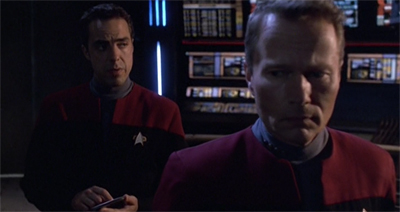
In for a Rudy awakening.
In Equinox, Part II, Janeway’s descent and Ransom’s redemption seem shallow and awkward; the rough sketch of two character arcs moving in opposition rather than a clearly-defined portrait. This is particularly true of Ransom, who finds himself haunted by the act of torturing Seven of Nine. Ransom has overseen the murder of dozens of sentient aliens, but it seems awfully convenient that torturing one blonde human woman should be the act that sets him over the edge. He had, after all, left Janeway and Voyager to die at the climax of Equinox, Part I.
There is something potentially interesting and provocative here, in the idea that the computer-generated aliens are just “too alien” for Ransom to feel empathy towards them, a cynical acknowledgement of how rarely human compassion reaches beyond the familiar. This is something with which Star Trek has grappled since The Devil in the Dark, and which Deep Space Nine returned to in Chimera. What does it say about Ransom that torturing Seven of Nine bothers him more than killing dozens of sentient aliens?
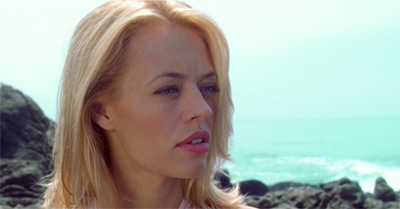
“What’s a girl like you doing in a conscience like this?”
Equinox, Part II never explores that question, because the episode isn’t particularly interested in the nuance of Ransom’s moral awakening. Equinox, Part II simply needs to get to a point where Ransom can make a plausible grasp at redemption, without pausing to analyse whether Ransom and his crew were able to justify their mass murder precisely because their victims did not look like Jeri Ryan. Equinox, Part II takes the quickest route to a comfortable denouement, never stopping to take in the scenery along the way.
This is more obvious in how the episode approaches Janeway’s breakdown, as she walks right up to the edge of the line in her efforts to hold Ransom to account. This is most obvious in the sequence where Janeway threatens to feed Lessing to the aliens. In the corridor outside the cargo bay, Janeway and Chakotay listen to the sounds from inside. “He’ll break,” Janeway states, as if to assure herself as much as Chakotay. However, it is Chakotay who breaks first, storming the cargo bay in direct contravention of Janeway’s orders.

Noah way out.
It is an impressive and tense sequence, but it never feels like part of anything larger. Is Janeway’s reckless torture of Lessing any worse than some of the things that the character has done over the past few seasons? As Arturis points out in Hope and Fear, Janeway has a lot of blood on her hands following her alliance with the Borg in Scorpion, Part I. Even ignoring the mitigating factors in that case, Janeway forced members of her senior staff to undergo serious procedures against their explicit wishes in both Nothing Human and Latent Image.
Indeed, Equinox, Part II seems to be nudging Chakotay close to leading a mutiny against Janeway. “We’ve had our disagreements, Chakotay, but you’ve never openly opposed me,” Janeway admits at one point, glossing over Chakotay’s direct countermanding of her standing orders in Scorpion, Part II. Nevertheless, Equinox, Part II does hint at the idea that Chakotay might have to take radical action to prevent Janeway from crossing a line. This would fit with the parallels between Ransom and Janeway; Burke leads a similar mutiny against Ransom later in the episode.

“What about Scorpion, Part II?”
“I thought we hit the reset button at the end of The Gift?”
“Fair point.”
However, Equinox, Part II never crosses that particular line. “You know, you may have had good reason to stage a little mutiny of your own,” Janeway concedes at the end of the episode. Chakotay explains, “The thought had occurred to me, but that would have been crossing the line.” This is an interesting and unsettling argument, but one entirely consistent with Voyager‘s world view. More than any other Star Trek series, Voyager is strongly devoted to the idea of order and structure, and believes that any disruption to the established order will have disastrous consequences.
This conservatism is reflected in several different ways across the run of Voyager, particularly in how it approaches storytelling. As a rule, Voyager was strongly invested in the status quo, in the belief that there was an established order to things and the way in which the universe was meant to operate. After all, Voyager had placed all its former terrorists in Starfleet uniforms by the end of Caretaker. The show was very fond of the “reset button”, to the point that even episodes that did not literally erase themselves from continuity rarely had any long-term impact on the series.
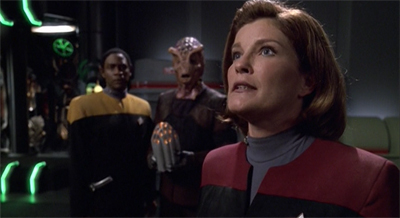
“Why can’t you forget about this horrific experience and move on? We do it all the time.”
Equinox, Part II seems to suggest that Chakotay’s duty is to Janeway rather than his own conscience; whatever Janeway might do, Chakotay mutinying would be worse. Equinox, Part II seems to suggest that this loyalty and devotion is what separates Voyager from Equinox, that the moral decay of the Nova-class ship culminates in Burke refusing to follow orders. This is the sin that finally causes Equinox to collapse upon itself, the point of no redemption. Ransom’s murder of dozens of aliens can be forgiven, but Burke’s mutiny is just too much.
Much like Ransom’s sudden attack of conscience for torturing Seven of Nine, there is something very uncomfortable in this assumption. Equinox, Part II seems to suggest that there is never a situation where Chakotay directly challenging Janeway would be acceptable. It is an argument for trusting authority and power structures. (Tellingly, one of the few Equinox crew members to be redeemed is Ensign Gilmore, who remains loyal to Ransom in the midst of Burke’s mutiny.) Watching Equinox, Part II, it seems like Janeway isn’t mad at Ransom for mass murder, but for violating protocol.

Mutiny to the Max.
This is an unsettling assumption, but one perfectly in keeping with Voyager‘s larger world view. Deep Space Nine was a television series about questioning and interrogating authority, while Voyager places a lot of trust in its institutions. Voyager could never have been about anything but a standard Starfleet ship, and Equinox, Part I and Equinox, Part II serve as a weird vindication of that approach. Equinox is a ship that dared to question the rigid structures that Janeway enforced upon the Maquis, and suffered for the consequences.
Of course, all of this skirts around the question of what happens when immoral actions take place within that framework; if the priority is upholding the integrity of the command structure, what happens when that command structure is used to do horrible things? Equinox, Part I alludes to this in Chakotay’s discussions with Gilmore. “You could have stopped yourself,” he states. “Why didn’t you?” Gilmore replies, “I don’t know. When the Captain ordered me to modify the warp core, I concentrated on the work. I tried not to think about how it was going to be used.”
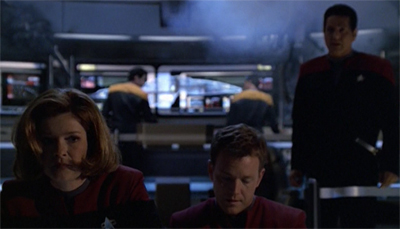
Damage control.
This short conversation in Equinox, Part I would seem to justify an attempted mutiny against Janeway in Equinox, Part II. Much like Gilmore in Equinox, Part I, Chakotay spends most of Equinox, Part II witnessing his commanding officer conducting morally dubious actions and remains paralysed. However, Equinox, Part II seems to argue that this paralysis is the best course of action, that any more significant act of rebellion against an immoral authority figure would risk the total collapse of the ship’s moral hierarchy.
This is not the only way in which Equinox, Part II seems to ignore set-up from Equinox, Part I. Indeed, Equinox, Part I devotes considerable time to the long-since-ended relationship between Maxwell Burke and B’Elanna Torres. In Equinox, Part I, Burke playfully uses her old nickname in the messhall, and uses her affection for him as a way to sabotage Voyager. However, there is no pay-off for this set-up in Equinox, Part II, beyond a short five-line communication between the pair during a heated battle that ends when Burke closes the channel.

“You’ve been Burked.”
Narratively speaking, this should be a big deal. After all, the odds of anybody on Voyager knowing anybody on the Equinox should be astronomical; there are countless active ships and countless active officers, even before considering that a significant portion of Voyager’s crew are former terrorists and a significant portion of the Equinox crew are dead. As such, the relationship between Torres and Burke is a huge plotting contrivance. It needs to be justified in narrative terms, there needs to be something in the story that explains why the audience is asked to make that leap.
However, Equinox, Part II makes this whole plot point incidental. The only big take away from the interactions between Torres and Burke is that Torres once had the nickname “B.L.T.”, because her full name sounds like it would have the same initials as the sandwich. This is hardly an earth-shattering revelation, or anything that reveals anything particularly insightful about Torres or Burke. To be fair, the introduction of the relationship in Equinox, Part I was most likely a result of the hectic schedule and motivated by a desire to fill the runtime. However, it still feels like Equinox, Part II bungles the follow-through.

Nova escape.
Then again, it is not as if Voyager follows through in any way from Equinox, Part I and Equinox, Part II. There are no lasting consequences from the episode. Janeway never seems to ask any tough questions of herself in the wake of the incident, and there is no damage inflicted upon the relationship between Janeway and Chakotay. As usual on Voyager, absolutely everything is put back in its place at the end of the two-parter, with Janeway’s replacing of the ship’s plaque the symbolic capstone.
Indeed, the Equinox crew members who are coopted into Voyager’s crew at the end of Equinox, Part II are completely forgotten about as soon as the closing credits roll. “Noah Lessing, Marla Gilmore, James Morrow, Brian Sofin, Angelo Tassoni, you are hereby stripped of rank,” Janeway warns them. “Your privileges will be limited, and you’ll serve under close supervision for as long as I deem fit. This time, you’ll have to earn our trust.” However, that redemption remains unseen, even if later-season episodes like Good Shepherd seem well-positioned to explore it.

“I don’t ever want to see any of you again. Report to Lieutenant Carey’s detail.”
I just hit the ceiling. I remember writing in the margins, ‘This is a total betrayal of the audience. This is wrong. You can’t end the show like this. If you are going to do all this other stuff, you can’t end the show like this, because it’s not fair, because it’s not true, and it just wouldn’t happen. But the show is what the show is.
Equinox, Part II would be the only episode of Voyager to make it through production while Moore was working on the series. He left after finishing the script to Survival Instinct and after working on the story to Barge of the Dead, but the producer fought a lot of battles over Equinox, Part II.

Darkest hour.
In some ways, Moore’s work on Battlestar Galactica would exist in conversation with his short stint on Voyager and in particular in his extreme reaction to Equinox, Part II. The basic premise of Voyager evokes the set-up of Battlestar Galactica, with a small collection of human characters forced to fend for themselves in the wilderness while searching for a way to Earth. In many ways, Battlestar Galactica became the show that Moore had wanted Voyager to be, free of the creative limitations imposed by Brannon Braga, Rick Berman, and the expectations of syndication.
Battlestar Galactica would not debut until three years after the end of Voyager, and following a variety of odd-jobs around the industry on shows like G vs. E and Carnivale. However, many would come to see Battlestar Galactica as Moore’s magnum opus, as the culmination of his career writing science-fiction and as the writer finally breaking through the limitations that the Star Trek franchise had imposed on his work. Battlestar Galactica was arguably a more satisfying follow-up to his work on Deep Space Nine than his brief stint on Voyager.
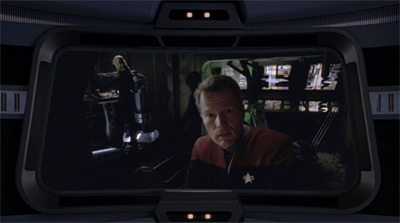
Engineering a mutiny.
The truth was, it was still Star Trek, and I think there were things I wanted to do with Voyager that I could never really accomplish. I couldn’t do those things until I went to Battlestar. I was talking about roughing up the ship, having the culture of the ship degenerating, having more divisions and camps within the crew. They’re out on the other side of the galaxy and away from home for a very, very long time with no real notion of when they’d get back, and I thought that would start to develop their own culture, or cultures, within the ship, that that would become a challenge to the military hierarchy of the starship. I wanted to go down some really dark roads, with the ship falling apart, the crew falling apart and at each other’s throats periodically and vying for control. The truth is I don’t know that I really could have done that at Star Trek, no matter what the political circumstances were, because the show was not designed to tell that kind of story and it really would have flown in the face of a lot of things Gene had set up and that he had said were important to him. So I think I probably had somewhat unrealistic goals of where I wanted to go (with Voyager), but then I found an opportunity to do them on Battlestar.
Of course, Moore is correct here. Even nineties network broadcast standards and practices would have made it impossible to create something like Battlestar Galactica on UPN under the Star Trek brand. This is not to excuse Voyager‘s creative compromises; there should have been a possible middle-ground.

The brains of the operation.
The parallels are not merely conceptual. Pegasus, a second season episode of Battlestar Galactica, seems to owe a conscious debt to Equinox, Part I and Equinox, Part II. In that episode, the lead characters discover another ship in a similar predicament, populated by a crew that have abandoned their humanity in order to survive. The parallels were strong. While Voyager shied away from the challenges raised by Equinox, Part I and Equinox, Part II, Battlestar Galactica embraced the opportunities presented by Pegasus.
Battlestar Galactica made a point to carry over some sense of continuity from Pegasus. Even after the original crisis was resolved, the eponymous ship remained a part of the support fleet until its destruction in Exodus, Part II. Characters introduced in Pegasus went on to play an important role in the long-term mythology of the show, with the victimised Gina detonating a nuclear warhead in the second season finale Lay Down Your Burdens, Part II, an action that was implied to have attracted the attention of the Cylons who occupied the planet.

Strong as an (Equin)ox.
Indeed, Battlestar Galactica would commit to the very concept of Pegasus, eventually releasing a feature-length television movie – Battlestar Galactica: Razor – that offered a glimpse of the experiences and events that shaped the crew of that other cruiser. It rounded out the concept, allowing the series to paint these flawed individuals as more than just two-dimensional monsters. It provides a sharp contrast to the cookie-cutter redemption of Ransom or the one-dimensional ruthlessness of Burke in Equinox, Part I and Equinox, Part II.
Equinox, Part II is a mess of an episode, one that falls apart through lazy plotting, a betrayal of its core premise, and a refuse to really address any of the tough questions at its core. It doesn’t work at all.
Filed under: Voyager | Tagged: battlestar galactica, Brannon Braga, equinox, ransom, ronald d. moore, star trek: voyager, voyager |




















Savage is a fine actor and I’m sorry his epiphany came so late in the episode. I prefer him in a “white hat”.
This was just one of those stories where you had to laugh. Why is Janeway suddenly pounding the rulebook? Why are they treating this like Moby Dick, when the story has already been done before (and better) in “Year of Hell”, or heck, First Contact? Why is the ex-Borg suddenly a moral arbiter? Why does Ransom want to get in Seven’s pants? Wouldn’t she incriminate him the minute he sets foot on Earth?
I’m all for breaking with routine and taking the characters out of their comfort zones, but the writing is so random that’s impossible to get invested to any serious degree.
Between this and “Sic Alice on me” (coming soon), it’s clear the VOY writers have lost interest in their corner of the Trek universe.
Equinox, Part II is a clusterf&!k of an episode. Which is a shame, given how well Equinox, Part I works. (When it really, really shouldn’t.)
I noticed the logic hole with the Ankari presence spanning 10,000+ light years as well. It is peak Voyager hand-waving. “Don’t think to hard about this. Just enjoy the action!”
Janeway’s supposed moral fall here just seems par for the course. She’s done this kind of thing before, and this is the way she will act to end the series in the finale. Chakotay’s role is to be a passive enabler, for the most part.
That said, Kate Mulgrew’s angry stare after Chakotay goes against her is truly bone chilling. She really does play a monomaniacal nutjob quite well.
I agree with having a middle-ground when it comes to this premise. It doesn’t need to be utterly bleak and nihilistic, but Voyager goes too far the other way. Having a defined seven season run like Voyager’s means that the show could’ve dedicated each season to showing the ship getting a little more run-down and the crew dynamics shifting, without going too far into cynicism, but the show never had that kind of progression.